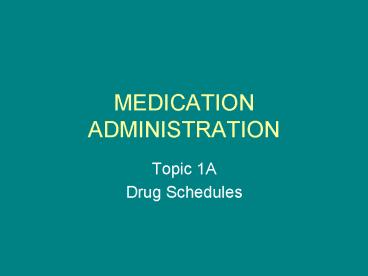MEDICATION ADMINISTRATION - PowerPoint PPT Presentation
1 / 25
Title:
MEDICATION ADMINISTRATION
Description:
MEDICATION ADMINISTRATION Topic 1A Drug Schedules * Orders should not be obliterated. Identify the schedules of drugs relevant to nursing practice It is the Poisons ... – PowerPoint PPT presentation
Number of Views:1173
Avg rating:3.0/5.0
Title: MEDICATION ADMINISTRATION
1
MEDICATION ADMINISTRATION
- Topic 1A
- Drug Schedules
2
Identify the schedules of drugs relevant to
nursing practice
- It is the Poisons and Therapeutic Goods Act 1966
( NSW ) who impose some limitation on the use of
many potent drugs by restricting their
distribution to certain groups or persons trained
in handling them and permitting their
administration only on medical authority.
3
It is the Poisons and Therapeutic Goods Act
provides for the establishment of a Poisons List,
which consists of eight schedules.
4
SCHEDULED DRUGS
- ( DANGEROUS POISONS )
- Extreme danger to life. Only available from
Medical Practioners - e.g. Atropine, Arsenic
5
2. Medicinal Poisons Poisons for therapeutic use
which are available to the public only from
pharmacies. Dangerous to life if misused or
carelessly handled. e.g. Panadol, Aspirin,
Codeine
6
3. Potent Substances
- Poisons for therapeutic use, which are dangerous
or liable to abuse. Their availability to the
public is restricted to supply by pharmacists and
medical practioners/ dentists/ vets. - e.g. Insulin
7
4. Restricted Drugs
- Substances which in the public interest should
be supplied only on the written prescription of a
medical practitioner, dentist or veterinary
surgeon. - e.g. Oral hypoglycaemic agents, Cortisone
- Barbiturates.
8
4D. Prescribed Restricted Substances
- Substances which are also only available to the
public on the prescription of an authorised
person. These substances are treated differently
because of their potential for misuse and abuse. - e.g. Diazepam, Midazolam
9
5. Domestic Poisons
- Poisons of a hazardous nature, which are readily
available to the public but require caution in
handling storage and use. - e.g. Bleach, Hydrogen peroxide
10
6. Industrial and Agriculture
- Substances which should be readily available to
the public for agricultural, pastoral,
horticultural, veterinary, photographic or
industrial purposes or for the destruction of
pests. - e.g.Phenol
11
7. Special Poisons
- Poisons which require special precautions in
manufacture, handling, storage or use or special
individual regulations regarding labelling or
availability. - e.g. Insecticides
12
8. Drugs of Addiction
- Substances which produce addiction or have such
potential. A drug register must be kept. - e.g. Morphine, Pethidine
13
STORAGE
- Nurse in charge of the ward is responsible for
the storage of all drugs. Must met legal
requirements that is security, temperature and
stock rotation. - Storage should be such a way that it minimises
errors
14
GENERAL SCHEDULE 4 MEDICATIONS
- Must be stored out of patient and public access.
( locked cupboard, locked room or locked
medication trolley ). - Keys kept by the nurse in charge of the ward or
their delegate who must be a registered
/authorised enrolled nurse. - Emergency or anaesthesia trolleys are exempt for
locked storage
15
DRUG KEYS
Please note that Drug keys must be kept from
ward keys.
16
SCHEDULE 4 APPENDIX D
- Liable to abuse
- Stored separate from all other drugs except S8
- No other goods should be stored in the same
place ( e.g. cash, keys ) - S4D Drug key and S8 keys can be kept together
but with no other ward keys and carried by an RN.
17
SELF MEDICATIONS
Stored in a secure bedside storage that is
inaccessible to other patients or visitors e.g.
locked bedside drawer to which the patient may
hold the key.
18
STORAGE IN ORIGINAL PACKS
- All drugs should be stored in their original
packs or containers as received from Pharmacy
19
MEDICATION INCIDENT REPORTING
- Part of quality improvement programs, should
have a system in place. - All disciplines should be encouraged to report
incidents even near miss incidents - Drug committee for review.
- Circular Incidents Reportable to the
Department 97/58.
20
MEDICATION ORDERS
What do you think should be included on the
medication order ?
21
Medication Order
- Must use a patient medication chart ( area
health logo ) - Allergies/ adverse drug reactions
- Clear, legible and unambiguous
- Patient full name, DOB,MRN and or address.
- age, weight of a paediatric patient
22
Medication Order
- Name of medication ( what name trade chemical or
generic ?? ) - Strength of medication
- Form of medication
- Dose, route, and frequency
- Date of cessation, total number of doses or
finite time period of administration.
23
Medication Orders
- Signature and date. Each individual medication
order must be written in a separate box and each
medication order must be signed. - To cease a medication order the MO must draw a
line across the area of the chart where
administration is recorded ( after the last entry
) and sign and date adjacent to this line.
24
Medication Orders
- If a drug is not to be given on certain days,
the prescriber must cross out those days on the
medication chart, to prevent errors. - Medication orders must not be duplicated so the
drug is not administered twice in error/
25
Medication Orders
- A MO should confirm their intention to order any
dose that could be considered to be unusually
high by underlining and initialling the dose.































